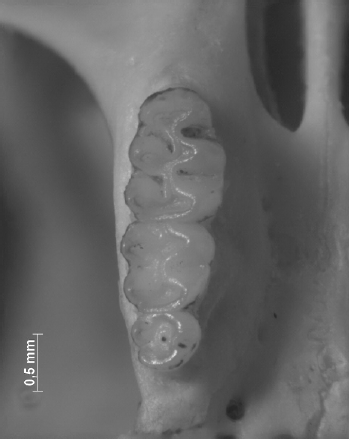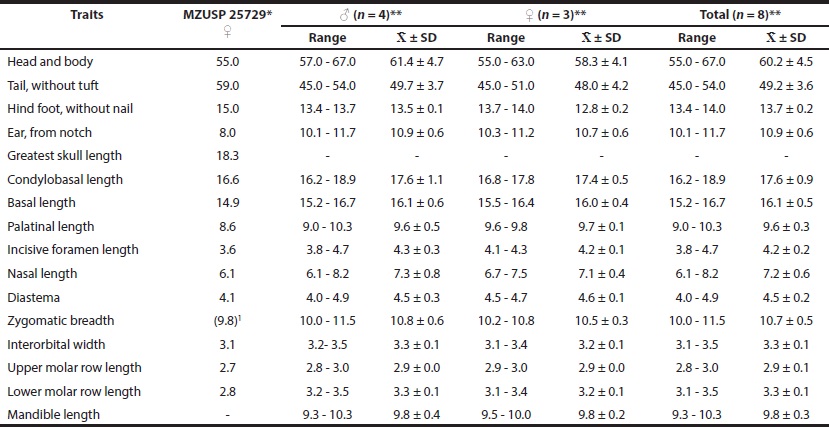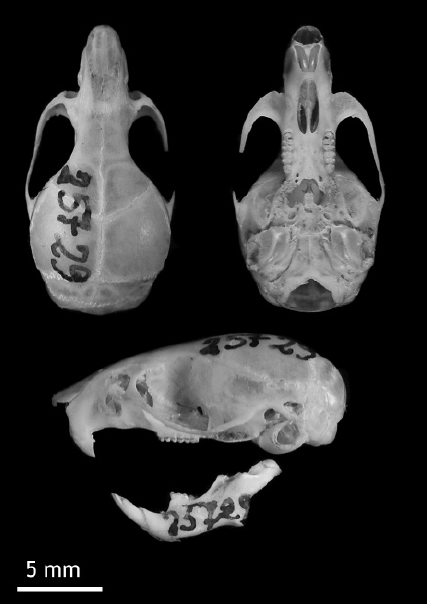Introduction
Species of the genus Calomys Waterhouse, 1837 are small, mostly granivorous, rodents of the tribe Phyllotini. Despite being broadly distributed throughout open vegetation formations in South America and on islands off Venezuela, the genus remains poorly known. According to the most recent taxonomic account (Salazar-Bravo 2015), Calomys is composed of the following species: C. boliviae (Thomas 1901), C. callidus (Thomas 1916), C. callosus (Rengger 1830), C. cerqueirai Bonvicino, Oliveira and Gentile 2010, C. expulsus (Lund 1841); C. hummelincki (Husson 1960), C. laucha (Fischer 1914), C. lepidus (Thomas 1884), C. musculinus (Thomas 1913), C. sorellus (Thomas 1900), C. tener (Winge 1837), C. tocantinsi Bonvicino, Lima and Almeida 2003, C. venustus (Thomas 1894). In addition, at least three new species have been described in the last couple of years (Zeballos et al. 2014; Gurgel-Filho et al. 2015) and two more were resurrected from under the synonymy of C. sorellus (Zeballos et al. 2014), bringing the overall total to 18 currently recognized species.
The genus has a disjunct distribution with most species inhabiting grasslands, savannas, and forest edges from ca. latitude 8° S in the highlands of Peru and the Caatinga of Brazil to ca. latitude 16° S in central Bolivia, and from there south into Argentine Patagonia (Salazar-Bravo 2015). One species (C. hummelincki) occurs in grasslands and open habitat formations in northern South America (Colombia and Venezuela) and on the Netherland Antillean islands of Curaçao and Aruba (Martino et al. 2002; Salazar-Bravo 2015). Currently, eight species of Calomys are thought to occur in Brazil: C. callidus, C. callosus, C. cerqueirai, C. expulsus, C. laucha, C. tener, C. tocantinsi, and C. mattevii (see Paglia et al. 2012; Gurgel-Filho et al. 2015).
Herein we report the first record of Hummelinck’s vesper mouse (C. hummelincki) from Brazil, based on a specimen obtained in an enclave of dry tropical savanna surrounded by rain forest in the state of Roraima.
Methods
The new specimen consists of a skin and skull (Figure 1) deposited in the mammal collections of Museu de Zoologia da Universidade de São Paulo (MZUSP 25729), São Paulo, Estado de São Paulo, Brazil. It is a young adult female (toothwear age class 3, sensu Voss 1991) collected on March 13, 1989 by C. M. Carvalho at Fazenda Salvamento, Estado de Roraima, Brazil. The specimen label indicates two embryos (preserved as MZUSP 25730).

Figure 1 Dorsal, ventral, and lateral views of the skull, and lateral view of the mandibles of Calomys hummelincki (MZUSP 25729).
According to C. M. Carvalho (2002), the MZUSP and Instituto Nacional de Pesquisa da Amazônia (INPA) made important expeditions to Roraima state between the years 1986 and 1991. Although the main effort was concentrated on herpetofauna, occasionally other groups were collected as well. Vanzolini and Carvalho (1991) described Fazenda Salvamento as a small cattle ranch located on the right bank of the Uraricoera River in northern Roraima state, Brazil (3.333° S, -61.400° W).
The collection site is within an area locally known as “lavrado”, a local term used for the savannas that occur in the general area and that form part of the Rio Branco-Rupununi bioregion (see Voss 1991: figure 38). The topography of the region is dominated by interconnected streams (“igarapés”) separated by small elevations, locally known as “tesos”. The ground cover is predominately grasses surrounding rocky outcrops. The vegetation is usually sparse, except on top of the “tesos” (Vanzolini and Carvalho 1991; Carvalho and Carvalho 2012). The climate in this region is characterized by a rainy season from April/May to August/September and a dry season from October to March. Average temperatures range between 22° and 30° C. Annual rainfall for 1989 was 1,884 mm (see Vanzolini and Carvalho 1991; Carvalho 1992).
Results
The new specimen is clearly a representative of the genus Calomys with body and skull measurements comparable only to those of C. laucha, C. tener and C. hummelincki (Table 1; see Bonvicino et al. 2010; Salazar-Bravo 2015). Moreover, based on the description in Salazar-Bravo (2015), MZUSP 25,729 exhibits all of the diagnostic external and craniodental characters of C. hummelincki, including grayish-orange dorsal pelage; mostly white ventral fur; distinct buffy post-auricular patches; weakly bicolored tail; short, narrow hind-feet covered with whitish hair; short and slender rostrum; shallow zygomatic notches; supraorbital region posteriorly divergent but not ridged; alisphenoid strut absent; greatest length of skull less than 21.0 mm; molar toothrow less than 3.3 mm (Figure 1). Other craniodental measurements for MZUSP 25,729 (Table 1) fall within the range of variation for this species.
Table 1 External and cranial measurements (in millimetres) of Calomys hummelincki specimens. Data are given as: minimum and maximum (Range), mean (

1 Approximated measurement, right zygomatic arch broken (see Figure 1).
Importantly, however, MZUSP 25,729 differs from other specimens of C. hummelincki in some traits, including a shallow (or absent) anteromedian flexus on M1 (versus a deeply divided M1 in individuals of the type series); presence of an anteromedian style, a trait present in fewer than 10 % of the specimens studied by Olds (1988); and a wider-than-average incisive foramen. Finally, MZUSP 25,729 has an upper molar series with molar proportions (M1:M2 and M2:M3) somewhat different from those in populations farther north. Of special note is the proportionally larger M3 (ca. 75 % of M2) in the specimen from Roraima (Figure 2), when compared to C. hummelincki from other populations (ca. 70 % of M2).
Discussion and Conclusions
The new record reported here extends the distribution of the species about 630 km SE from the nearest previous record (Sipao, Estado Bolívar, Venezuela; Figure 3). Although the range of C. hummelincki is still disjunct with respect to those of other species of Calomys in South America, the new record considerably decreases the gap between them.

Figure 3 Known records for Calomys hummelincki (modified from Salazar-Bravo 2015). The star represents the new record. Numbers in parentheses correspond to locality numbers on the map. Colombia: 1) Aruba, Sero Blanco, Colombia (12º 31’ N, -70º 01’ W); 2) Curaçao, Klein Santa Marta (12º 16’ 59” N, -69º 07’ 59” W); 3) Arroyo Cerrejón, Cabo de la Vela, La Guajira (12º 12’ 33”N, -72º 08’ 51” W). Venezuela 4) Falcón, Isiro (11º 56’ 57” N, -70º 05’ 58” W); 5) Zulia, near Cojoro, 34 Km NE Paraguaipoa (11º 37’ 59” N, -71º 49’ 59” W); 6) Zulia, confluencia Río Lajas con El Palmar (10º 39’ 44” N, -72º 17’ 54” W); 7) Lara, Cuarigua (9º 58’ 43” N, -69º 56’ 13” W); 8) Monagas, 8 Km NW Los Barrancos (9º 50’ 18” N, -63º 22’ 56” W); 9) Monagas, Hato Mata de Brejuco, 55 Km SE (9º 19’ N, -62º 55’ 59” W); 10) Anzoátehi, El Merey (9º 10’ N, -64º 43’ 59” W); 11) Bolívar, Sipao (7º 26’ 35” N, -65º 24’ 12” W); 12) Río Cinaruco, 38 Km NW Puerto Paez (6º 33’ N, -67º 31’ W); 13) pure, Puerto Paez (6º 12’ 27” N, -67º 27’ 04”W); Brazil: 14) Fazenda Salvamento, Roraima (3° 20′ N, -61° 24′ W).
The current arrangement of vegetation communities north of the Amazon basin, where series of savannas are intermingled with forests, may be explained by the expansion and contraction of forest habitats during the Quaternary. The specific plant physiognomy dominating a particular area is influenced by a combination of soil, climate and elevation (Pennington et al. 2000; Vivo and Carmignotto 2004; Barbosa et al. 2007). We suggest that during drier periods, C. hummelincki expanded its distribution into northern South America along with the expansion of savanna vegetation formations. If, however, C. hummelincki evolved in the grasslands and savannas of northern South America, expanded distribution toward the south, offers a parsimonious biogeographic alternative. Either way, the population reported here is isolated from other populations of the species by a large tract of Tropical Moist Broadleaf Forest, no less than 130-km-wide, which separates the Gran Sabana/Rio Branco-Rupununi complex from the llanos. Nonetheless, future faunal assessments should be alert to the possible presence of C. hummelincki in the Ventuari and Esmeralda savannas of southern Venezuela.
Although the Roraima savannas currently lack legally protected areas for the conservation of biodiversity, about 46% of the territory in this region is under the protection of the State as Indigenous land. With few exceptions (e. g., Barbosa et al. 2007), the mammal communities in the region are poorly known, especially as concerns small species such as marsupials, rodents, and bats. According to Voss (1991: table 30), only three out of nine non-forest mammals (Zygodontomys brevicauda, Calomys hummelincki, and Cavia aperea) occurring in northern South America are known from the Rio Branco-Rupununi savannas. Others, for example, Dasypus sabanicola and Lutreolina crassicaudata, are not known from the area, but are likely to occur there. This report, documenting the occurrence of C. hummelincki in this habitat, highlights the need to investigate and protect the biodiversity of the Rio Branco-Rupununi savannas. Further research on Calomys in this region is also needed to assess the genetic divergence of this isolated population.











 nueva página del texto (beta)
nueva página del texto (beta)



